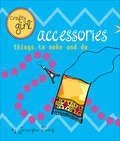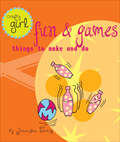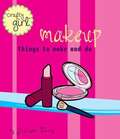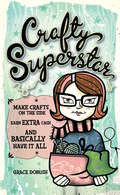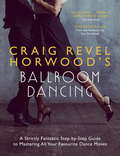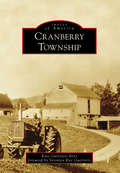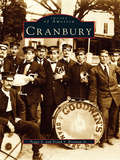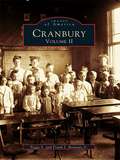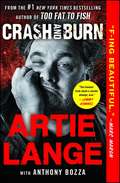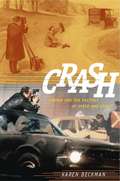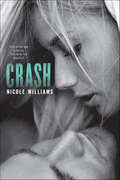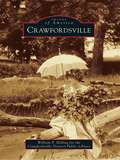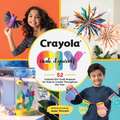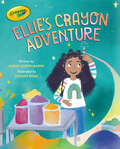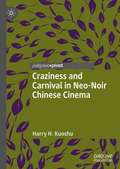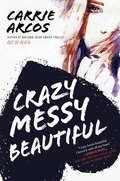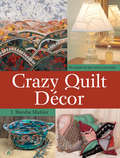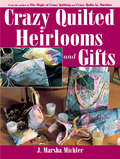- Table View
- List View
Crafty Girl: Accessories
by Jennifer TraigA crafty girl knows that true style comes by way of vision and daring-along with a healthy dose of sequins, fake fur, and funky fabric. Enter Crafty Girl: Accessories, the next book in the winning Crafty Girl series, and the grooviest-ever guide to making bags, hats, hair-wear, and more. From the pretty to the punk, its positively packed with projects to brighten up any wardrobe. Too cool for school? Not too cool for the Bohemian Backpack. And Starlet Sparkle shades make it easy to go incognito on those days when a crafty girl just cant bear the paparazzi. Kitten Mittens keep the paws toasty, and a Milkmaid Kerchief tames the tresses. With more than 40 projects and handy stencils at the back, Crafty Girl: Accessories is the ultimate handbook for creating sparkly, spangly fashion masterpieces.
Crafty Girl: Beauty
by Jennifer Traig Julianne BalmainWe know, beauty is only skin deep. But who doesn't love a healthy sparkle? Crafty Girl: Beauty is the ultimate guide to becoming fabulous from the inside out. With over 40 simple recipes you can whip up in the time it takes to skin an avocado, dozens of full-color illustrations throughout, sassy drawings, and attitude to burn, Crafty Girl is more than a book--it's a way of life.
Crafty Girl: Fun and Games
by Jennifer TraigOver forty fantastic ideas for creating your own activities and games that will make any time a good time. Bored in the backyard? Restless in your room? What&’s a crafty girl to do? Plenty. The trick to keeping the good times rolling is to craft like crazy. If you&’re restless in your room, bored in the backyard, or twiddling your thumbs on a long road trip, Crafty Girl: Fun and Games is your lifetime membership to the crafty carnival. Start by breaking the rules with Autobiographical Board Games. Go nuts in the kitchen with Kitchen Sink Cookies and other kooky experiments. Get busy with a Soda Bottle Bowling tournament or an afternoon of Hallway Croquet. Whip up some homemade art supplies and start your masterpiece or play a quick game of Custom Car-Bingo. With more than forty ideas for every variation on fun you can possibly imagine, Crafty Girl: Fun and Games will help you banish boredom forever.
Crafty Girl: Makeup
by Jennifer TraigEvery crafty girl knows that beauty comes from within, but she also knows that makeup can make life a little prettier, a little glossier, and a lot more fun. Crafty Girl: Makeup explains how to do it right, revealing the secrets to glowing skin, shapely brows, bright eyes, lovely lips, and so much more. Here are tips on what to buy and how to use it, plus lots of simple recipes for whipping up custom batches of glosses, blushes, and bronzers. But the fun doesn't end there. A section called The Looks offers up easy professional tips and step-by-step instructions for creating 20 different faces, from fresh to fabulous. Whether she's a clean teen or glamour queen, Crafty Girl: Makeup has it all: the hints, the help, and the looks she'll love.
Crafty Girl: Slumber Parties
by Jennifer TraigFourteen plans to make your next slumber party sensational and not a snooze fest, featuring ideas for snacks, games, movie marathons, and more.Crafty Girl: Slumber Parties answers the critical question: How to host a slumber party that isn&’t a snore? Here, complete plans for fourteen fabulous, themed fetes offer dozens of dreamy ideas for midnight munchies, hilarious games, clever crafts, fun sleepover flicks, and more. Guests will enjoy getting super-crafty at the all-night-long Beadapalooza, the sparkliest party around. The relaxing Bliss-Out Spa Party encourages attendees to chill, with beauty treatments and tasty refreshments fit for a film star. And the creepy Night on Haunted Hill will scare the squeals out of every girl in sight. The ultimate guide to partying in one&’s PJs, Crafty Girl: Slumber Parties lets any hostess transform an ordinary sleepover into a spectacular slumberama.
Crafty Mama: Makes 49 Fast, Fabulous, Foolproof (Baby & Toddler) Projects
by Abby PecorielloMarrying the new mother’s need to connect and the community spirit of crafting—think reading groups, Stitch ’n Bitch knitting circles, and, of course, playgroups—is The Crafty Mamas, a unique idea in DIY and a full-color guide filled with baby-related projects, essential techniques, tips on how to form a group, wisdom, inspiration, and camaraderie. Abby Pecoriello launched the first-ever crafting club for new moms during her maternity leave. The concept proved to be such a hit that in the two and a half years since, she’s led hundreds of sold-out Crafty Mamas classes throughout New York City. Now, in this spirited, witty book, she provides the how-to for women to form their own Crafty Mamas groups, from learning the best ways to reach out to other new moms in the area, to the nuts-and-bolts of running the group: setting a budget, buying tools and supplies, choosing a venue, and more. Then come the projects—50 hip, no-sew craft ideas that are inexpensive and easy to make, and will delight moms and babies alike: “Light the Night” nightlight, No-Sew Swanky Blankies, The Poncherello, Photo Au Go Go Bracelets, Hip Purses, Insta-Bibs, Peek-a-Books, Photo Bragnets. Includes simple tutorials on using a glue gun, editing digital photos, how to decoupage, jewelry basics, and more.
Crafty Superstar: Make Crafts on the Side, Earn Extra Cash, and Basically Have It All
by Grace DobushSell Out! If the church-basement sale isn't quite your scene, Crafty Superstar is your go-to resource for selling your crafty goods part-time. Packed with ideas for setting up and selling out, the book includes loads of advice from experts like Faythe Levine, Jenny Harada and Jenny Hart. Want to make some dough but don't know where to start? Inside find out how to: Discover your expectations and motivations Set up shop and get paid Join an indie craft show Get some press Package goods and customer service Balance life and crafts Plus, get business forms, lists of resources and a directory of indie craft shows so you can be on your way to becoming a Crafty Superstar!
Crafty TV Writing: Thinking Inside the Box
by Alex EpsteinA professional TV writer's real-world guide to getting paid to write great television"No need for me to ever write a book on TV writing. Alex Epstein has covered it all . . . along with a few things I wouldn't have thought of. Save yourself five years of rookie mistakes. Crafty TV Writing and talent are pretty much all you'll need to make it."—Ken Levine, writer/producer, MASH, Cheers, Frasier, The Simpsons, Wings, BeckerEveryone watches television, and everyone has an opinion on what makes good TV. But, as Alex Epstein shows in this invaluable guide, writing for television is a highly specific craft that requires knowledge, skill, and more than a few insider's tricks.Epstein, a veteran TV writer and show creator himself, provides essential knowledge about the entire process of television writing, both for beginners and for professionals who want to go to the next level. Crafty TV Writing explains how to decode the hidden structure of a TV series. It describes the best ways to generate a hook, write an episode, create characters the audience will never tire of, construct entertaining dialogue, and use humor. It shows how to navigate the tough but rewarding television industry, from writing your first "spec" script, to getting hired to work on a show, to surviving—even thriving—if you get fired. And it illuminates how television writers think about the shows they're writing, whether they're working in comedy, drama, or "reality."Fresh, funny, and informed, Crafty TV Writing is the essential guide to writing for and flourishing in the world of television.
Craig Revel Horwood's Ballroom Dancing: A guide to mastering the basic steps for absolute beginners
by Craig Revel HorwoodIs this the right book for me?Whether you are an absolute beginner, a Strictly Come Dancing wannabe or simply want a fun way to get fit, Craig Revel Horwood's guide to ballroom dancing offers something for everyone. Learn how to become a ballroom babe or a Latin lover as Craig shows you all the basic moves in a fun, lively and straightforward way. Easy-to-follow instructions and illustrations will help you to learn numerous dances, including the traditional foxtrot, waltz, and tango as well as the more modern mambo, rumba and samba. Each section of dance provides lots of suggestions for great music to strut your stuff to, with helpful tips from Craig to encourage you to practice until you have truly mastered your moves.Learn effortlessly with a new easy-to-read page design and interactive features: Not got much time?One, five and ten-minute introductions to key principles to get you started.Author insightsLots of instant help with common problems and quick tips for success, based on the author's many years of experience.Test yourselfTests in the book and online to keep track of your progress.Extend your knowledgeExtra online articles to give you a richer understanding of the subject.Five things to rememberQuick refreshers to help you remember the key facts.Try thisInnovative exercises illustrate what you've learnt and how to use it.
Craig Revel Horwood's Ballroom Dancing: A guide to mastering the basic steps for absolute beginners (Teach Yourself General Ser.)
by Craig Revel HorwoodIs this the right book for me?Whether you are an absolute beginner, a Strictly Come Dancing wannabe or simply want a fun way to get fit, Craig Revel Horwood's guide to ballroom dancing offers something for everyone. Learn how to become a ballroom babe or a Latin lover as Craig shows you all the basic moves in a fun, lively and straightforward way. Easy-to-follow instructions and illustrations will help you to learn numerous dances, including the traditional foxtrot, waltz, and tango as well as the more modern mambo, rumba and samba. Each section of dance provides lots of suggestions for great music to strut your stuff to, with helpful tips from Craig to encourage you to practice until you have truly mastered your moves.Learn effortlessly with a new easy-to-read page design and interactive features: Not got much time?One, five and ten-minute introductions to key principles to get you started.Author insightsLots of instant help with common problems and quick tips for success, based on the author's many years of experience.Test yourselfTests in the book and online to keep track of your progress.Extend your knowledgeExtra online articles to give you a richer understanding of the subject.Five things to rememberQuick refreshers to help you remember the key facts.Try thisInnovative exercises illustrate what you've learnt and how to use it.
Cranberry Lake and Wanakena (Postcard History Series)
by Susan Thomas SmebyIn the northwest corner of the Adirondack Park lie Cranberry Lake and the village of Wanakena. This remote area was the last-settled part of New York State; from the mid-1800s to the early 1900s, its name evoked the very essence of wilderness. Initially, sportsmen, naturalists, and artists flocked to the area. By 1900, summer tourism was booming. The logging industry followed, to harvest the virgin timber; after that, the state purchased the mostly cleared lands. Today, seventy-five percent of the lake's shoreline is state owned, and the Five Ponds Wilderness, south of Wanakena, is one of the largest and wildest areas in the Adirondacks.
Cranberry Township (Images of America)
by Veronica Rice Guerriero Kate Guerriero BenzIt is hard to imagine a version of Cranberry Township that was comprised of lush forests, gently rolling hills, and cascading waves of open fields. For the settlers who arrived here in the late 1700s, it was an Eden of abundant opportunity--tranquility that proved irresistible. They purchased hundreds of acres, built self-sustaining farms, and planted their roots. These pioneers had names like Graham, Garvin, Duncan, Meeder, Rowan, and Goehring, and many of their descendants still remain. While its name pays homage to the marshy bogs that produced succulent cranberries, its heritage is rooted in humble beginnings that remained largely untouched for centuries. Only with the dawn of an expanding highway system beginning in the 1950s did Cranberry Township begin its rapid transformation from farm community to suburban hot spot.
Cranbury (Images of America #Vol. 1)
by Peggy S. Brennan Frank J. Brennan Jr.Few New Jersey towns have retained as much nineteenth-century charm as Cranbury. Set in agriculturally rich Middlesex County, Cranbury is known for its shuttered white-clapboard houses, lovely shaded streets, picket fences, and tranquil lake. First settled in 1697, Cranbury came of age more than one hundred years later when it developed into a bustling center with a gristmill, a sawmill, tanneries, blacksmith shops, and other business enterprises typical of small-town America. These images are fascinating: most of them have never before been published, and many of them were donated from family albums and collections. The recollections of many living residents have been included as well, and the stories, anecdotes, and memories breathe life into the images of a by-gone era. The result is a remarkable visual history, both informative and entertaining, that serves to preserve and celebrate Cranbury's proud heritage. Cranbury is a journey into the past that will thrill resident and visitor, young and old alike.
Cranbury: Volume II
by Peggy S. Brennan Frank J. Brennan Jr.One of New Jersey's oldest and most historic communities, Cranbury celebrated its 300th anniversary in 1997. Following the fantastic reception of Cranbury, an Images of America publication released in 1995, authors Peggy S. and Frank J. Brennan Jr. have developed the rich heritage of this community further in a marvelous second volume. The Brennans, Cranbury residents, reviewed more than 400 photographs to produce this vivid and thoroughly researched companion to the first book. They invite you to view the homes, churches, and public buildings that reflect a bygone era and discover the people, places, and events that contributed to life in Cranbury from the early nineteenth century through 1975. With its tree-lined Main Street and white, clapboard homes, old Cranbury brings to mind a simpler way of life in a younger, simpler America.
Crash and Burn
by Artie LangeVeteran comedian Artie Lange turns an unflinching eye and his signature wit on his perilous descent into drug addiction, life-threatening depression, and ultimately, his recovery, in the follow-up to his hilariously raw debut, the #1 New York Times bestseller Too Fat to Fish.At a high point in his career, Artie Lange played a sold-out show in Carnegie Hall and totally killed—yet during his standing ovation, all he could think of were the two bags of heroin in his pocket. In the midst of a deep, self-destructive depression, addicted to heroin and prescription drugs, he lashed out at everyone around him—from his fellow cast members on The Howard Stern Show, to celebrity guests, to his longtime friends, and even his own family. By turns dark and disturbing, hilarious and heartbreaking, and always drop-dead honest, the New York Times bestseller Crash and Burn lifts the curtain on Lange’s dangerous slide. For the first time, Artie reveals all: the full truth behind his now legendary Stern Show meltdown, his suicide attempt (which he relates in terrifying detail), surprising stints in rehab, and painful relapses. With the help and support of friends and family, Artie claws his way back, turning his life and career around. And despite his slip-ups, backslides, and permanent losses, Artie forges on.
Crash: Cinema and the Politics of Speed and Stasis
by Karen BeckmanArtists, writers, and filmmakers from Andy Warhol and J. G. Ballard to Alejandro Gonzlez Irritu and Ousmane Sembne have repeatedly used representations of immobilized and crashed cars to wrestle with the conundrums of modernity. In Crash, Karen Beckman argues that representations of the crash parallel the encounter of film with other media, and that these collisions between media offer useful ways to think about alterity, politics, and desire. Examining the significance of automobile collisions in film genres including the "cinema of attractions," slapstick comedies, and industrial-safety movies, Beckman reveals how the car crash gives visual form to fantasies and anxieties regarding speed and stasis, risk and safety, immunity and contamination, and impermeability and penetration. Her reflections on the crash as the traumatic, uncertain moment of inertia that comes in the wake of speed and confidence challenge the tendency in cinema studies to privilege movement above film's other qualities. Ultimately, Beckman suggests that film studies is a hybrid field that cannot apprehend its object of study without acknowledging the ways that cinema's technology binds it to capitalism's industrial systems and other media, technologies, and disciplines.
Crash: Includes Crash, Clash And Crush (Crash #1)
by Nicole WilliamsIn this first book in the New York Times bestselling Crash trilogy, the world is introduced to this generation's Romeo and Juliet: Jude Ryder and Lucy Larson—Explosive. Sizzling. Tragic.A steamy summer encounter with bad boy Jude means trouble for Lucy. Her sights are set on becoming a ballerina, and she won't let anything get in her way . . . except Jude.He's got a rap sheet, dangerous mood swings, and a fate to ruin the lives of girls like Lucy—and he tells her so.But as rumors run rampant and reputations are destroyed, Lucy's not listening to Jude's warning. Is tragedy waiting in the wings? Or could this be the true love that every romantic dreams of? With red-hot chemistry and shocking twists, this is a love story that is not to be missed.
Crawfordsville (Images of America)
by William P. Helling Crawfordsville District Public LibraryCrawfordsville, founded in the early 1820s, has a diverse history for a small town located in rural, west-central Indiana. The town was the site of an important land office, which attracted many settlers, as well as speculators, to the area. Crawfordsville became known for its intellectual and progressive atmosphere and earned the nickname of the "Athens of Indiana," especially for the numerous residents with literary accomplishments. Wabash College was established in Crawfordsville in 1832, and the institution's teachers and students have contributed greatly to the development of the town's culture and prestige. In addition to its authors and poets, Crawfordsville has had its share of musicians, artists, soldiers, and statesmen who have played a role far beyond the borders of Montgomery County, of which Crawfordsville is the seat. Images of America: Crawfordsville is a photographic tour of the people and places that have marked this town from its early days. Some 200 historical images capture the town's development, along with its interesting, and often unique, accomplishments.
Crayola: 52 Colorful DIY Craft Projects for Kids to Create Throughout the Year
by Crayola LLCInspire creativity with fifty-two seasonal arts and crafts activities from Crayola -- the number one name in color and classic DIY crafts for kids -- that will help grow your child's confidence, while building a passion for learning new skills!Crayola has been unleashing creativity and self-expression for the last 117 years. Since early 2018, their CIY (Create It Yourself) videos have showcased new and exciting ways for kids ages six and up to use Crayola products to create Instagram-worthy works of art.Crayola: Create It Yourself includes fifty-two of the most popular and fun craft projects, organized by the four seasons: fall, winter, spring, and summer. Kids will create DIY gifts like Mother's Day picture frames and Valentine's Day Lanterns, they'll decorate the house with Haunted Halloween Decorations and Melted Crayon Ornaments, and they'll make timeless paper spinners and CIY terrariums for use all year round. Each activity includes a complete art supply list, clear step-by-step photographs and instructions, as well as finished samples.Perfect for use at home or in the classroom, the Crayola: Create It Yourself Activity Book encourages kids to put down their digital devices, pick up their crayons, and get creative.
Crayola: A Visual Biography of the World's Most Famous Crayon
by Crayola LLC Lisa SolomonA vibrant and colorful history of Crayola crayons, from the company's origin story, the birth of the Crayola crayon, the evolution of the iconic crayon packages, and profiles of every Crayola color from Sky Blue to Carnation Pink. Everyone has a relationship with color. If you think back to your first memories of exploring color, there is a very good chance that crayons were involved. And when it comes to crayons, Crayola is king.This book explores the history of a beloved childhood art supply, while also delving into our relationship with color: how we use and create with color, and how we name colors. It looks at the history of the 120 iconic colors of Crayola and where they came from, and how Crayola itself has helped shape our understanding of color over the last century and a half. Finally, this book explores how people -- adults and children alike -- have and continued to turn to Crayola to inspire and manifest their creativity. Filled with hundreds of illustrations and archival photos, Crayola is a nostalgic and fascinating wonderland of creativity and delight.
Crayola: Ellie's Crayon Adventure
by Sarah Glenn Marsh Crayola LLCWelcome to a world of infinite colors!When Ellie and her class take a field trip to the Crayola Factory to learn how crayons are made, they are greeted by rooms full of color and bustling with activity. From mixing pigments to wrapping and sorting, there are machines and people hard at work at every turn. There are even magical creatures called color catchers who travel the world in search of Pacific Blue, Wild Watermelon, and Sunglow who really steal the show. But it isn't until Ellie accidentally knocks into some equipment that she and her friends learn just how limitless the world of color possibilities can be.
Craziness and Carnival in Neo-Noir Chinese Cinema (Chinese Literature and Culture in the World)
by Harry H. KuoshuCraziness and Carnival in Neo-Noir Chinese Cinema offers an in-depth discussion of the “stone phenomenon” in Chinese film production and cinematic discourses triggered by the extraordinary success of the 2006 low-budget film, Crazy Stone. Surveying the nuanced implications of the film noir genre, Harry Kuoshu argues that global neo noir maintains a mediascape of references, borrowings, and re-workings and explores various social and cultural issues that constitute this Chinese episode of neo noir. Combining literary explorations of carnival, postmodernism, and post-socialism, Kuoshu advocates for neo noir as a cultural phenomenon that connects filmmakers, film critics, and film audiences rather than an industrial genre.
Crazy Messy Beautiful
by Carrie ArcosFrom National Book Award finalist Carrie Arcos--a fresh take on happily ever after, and friendship, that is anything but a love story.When your namesake is Pablo Neruda—the greatest love poet of all time—finding “the one” should be easy. After all, sixteen-year-old aspiring artist Neruda Diaz has been in love many times before. So it’s only a matter of time before someone loves him back. Callie could be that someone. She’s creative and edgy, and nothing like the girls Neruda typically falls for, so when a school assignment brings them together, he is pleasantly surprised to learn they have a lot in common. With his true love in reach and his artistic ambitions on track, everything is finally coming together. But as Neruda begins to fall faster and harder than ever before, he is blindsided by the complicated nature of love—and art—in more ways than one. And when the relationships he’s looked to for guidance threaten to implode, Neruda must confront the reality that love is crazier, messier, and more beautiful than he ever realized—and riskier, too, than simply saying the words.Praise for Crazy Messy Beautiful:"This satisfying and unconventional love story explores the various meanings of the word." --Kirkus Reviews"Arcos has written a classic story of a budding artist finding out the reality behind the artifice, and does sowhile keeping a wonderful sense of humor." --Booklist "Arcos capably probes the mysterious without attempting to solve it as Neruda discovers the difference between crushing on someone he doesn’t know and loving someone he does, learning that friendship, too, is a kind of love." --Publishers Weekly "With readily relatable characters who, nonetheless, surprise readers as they tackle life’s many challenges and gifts, Crazy Messy Beautiful . . . explores the complexities of human emotions, aspirations, creativity, and relationships. This eminently readable book will appeal to male and female readers alike." --VOYA
Crazy Quilt Décor: 50+ Projects for Any Room in Your Home
by J. Marsha MichlerJ. Marsha Michler, the leading designer and author in the area of crazy quilting, now joins the popular quilting technique with home decor. Quilters will follow her innovative techniques and step-by-step instructions for creating 30 crazy quilt home decor projects in popular themes such as Oriental, Victorian, Folk art, Country, Western and Whimsical. Featuring an excellent selection of projects for the home, including small quilts, window treatments, chair and table covers, pillows, baskets, picture frames, and lampshades, this book is well worth the investment. Quilters will learn several methods of crazy quilting, including topstitch applique, confetti piecing, the antique method, one-layer topstitch applique, the heirloom method, and collage method and the stained glass method.
Crazy Quilted Heirlooms & Gifts
by J. Marsha MichlerIn Crazy Quilted Heirlooms and Gifts, J. Marsha Michler translates this extraordinary Victorian art into tomorrow's heirlooms. Create a breathtaking window-treatment, sumptuous pieces for your living and dining rooms, gifts to shower upon the newest baby in the family, or a steal-the-show evening scarf that your granddaughter will be proud to pass down to her granddaughter.Crazy Quilted Heirlooms and Gifts showcases 30 compelling projects that you'll be inspired to craft for your home and garden, including: • Showpiece Wall Quilt • Festive Gift Bags • Pendant Purses • Tea Set • Garden notebook coverEach chapter of the book features needle arts such as Battenberg lace making, Shadow Work, Silk Ribbon and Wool Embroidery, and much more.Step-by-step instructions include photographs and easy-to-follow diagrams, along with suggestions for fabrics and colors, and complete materials listings.
